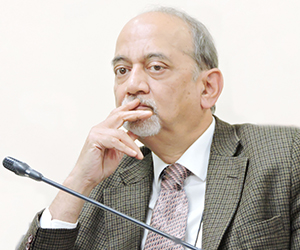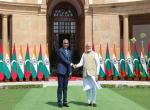Supreme Court’s historic judgment on the deletion of Article 370 has settled the legal questions raised by the petitioners. The Court has stated that the provision was temporary, and the President had the power to issue a proclamation for deleting it. The Court mentioned Yuvraj Karan Singh’s proclamation of November 25, 1949, that ‘the Constitution of India would not only supersede all other constitutional provisions in the State which were inconsistent with it, but also abrogate them’.[1] The Court said this reflects the full and final surrender of sovereignty by J&K to India. This laid to rest the contention of some of the parties to the case that though the State had acceded to India, it still enjoyed internal sovereignty. The judgment has called for restoring the statehood for J&K but upheld the government’s decision to set up Ladakh as a Union Territory. The Court has rejected the contention that the move was against the federal structure. The judgment called for the holding of elections in the state before 30th September 2024.
While Article 370 was in force, Pakistan never accepted the Indian argument that ‘autonomy’ within India’s federal structure was a sufficient safeguard for the people of the State. After its abrogation in 2019, it started a high-pitched campaign against the Indian move. In the wake of the Supreme Court decision, Pakistan’s caretaker Foreign Minister Jalil Abbas Jilani said that the final disposition of the State of J&K is to be made in accordance with the relevant United Nations Security Council (UNSC) resolutions and as per the aspirations of the Kashmiri people.[2] Has Pakistan observed UNSC resolutions on J&K? Did it ever provide autonomy to POK? It claims that POK is ‘Azad’ or free. How far is this slogan reflected in the governance structure of the territory?
Pakistan has a basic problem with UN Security Council resolutions on Kashmir. The UN Security Council resolution of April 1948, as well as the UNCIP resolution of August 1948, asked Pakistan to withdraw from the territory of J&K which it had illegally occupied. Pakistan did not want to let go of its illegal gains. The call for a plebiscite under the United Nations Commission for India and Pakistan (UNCIP) resolution of August 1948 was predicated upon Pakistan's withdrawal. It has instead consolidated and perpetuated its rule over the territory in breach of the UN resolution.
Pakistan’s official position is that POK is ‘Azad’, and its future will be decided by plebiscite as mandated under the UN Security Council resolution. Unknown to the outside world, it had brought Northern Areas under its direct administration seven decades ago. Its current narrative is that this was done under the Karachi Agreement of 1949 between Pakistan and POK leaders. However, this was not admitted at the time. It was kept secret since Pakistan had changed the territorial status quo without a plebiscite in breach of UNSC resolutions.
Karachi Agreement came to light in 1993 in a landmark judgment of the POK High Court. The case was initiated by a plaint of all the political parties of POK, including the Muslim Conference. The party had supported the demand for Pakistan at the time of partition. Now it wanted Pakistan to return the part of the territory of J&K state to POK. The High Court described the separation of the Northern Areas as a violation of UNSC resolutons by Pakistan.[3] It called for the return of the territory to POK. Pakistan, however, pressurized the POK Supreme Court to overturn the High Court’s judgment on purely procedural grounds. ‘Azad’ Kashmir has been permanently divested of 85% of its territory.
There is something missing in this narrative. Northern Areas were under Gilgit Agency which had been retroceded to Maharaja’s government on the eve of partition. The flag of revolt against Maharaja’s administration in Gilgit was raised by Major Brown on 31st October 1947. Brown was a British officer who headed Gilgit Scouts. There is perhaps no parallel where the ‘indigenous struggle’ is led by an officer representing the colonial masters. He has described in his memoirs that he handed over the charge of the territory to Mohammad Alam, Pakistan’s political agent on 16th November.[4] A ‘provisional government’ of POK had been declared three weeks earlier on 24th October. The logical course was to hand over the Northern Areas to POK since it was part of the erstwhile Kashmir state. Instead, it was taken over by Pakistan. This was done two years before the so-called Karachi Agreement of 1949, which was simply devised to provide ‘legal’ (?) cover to a de-facto control. Sardar Ibrahim Khan, the first President of POK, who is supposed to have ceded Northern Areas to Pakistan, denied in his later life ever having signed the Karachi Agreement.
Pakistan’s caretaker Foreign Minister Gilani in his comments on the deletion of Article 370 also stated that the final disposition of the state of J&K will be made on the basis of the ‘aspirations’ of the Kashmiri people. How are these reflected in the governing structures of POK? For more than two decades, POK was run on the basis of Rules of Business issued by the Ministry of Kashmir Affairs located in Rawalpindi. Mohammad Yusuf Sarraf, a senior Muslim Conference leader has described in his memoirs that a President of POK was asked by the Joint Secretary in the Ministry of Kashmir Affairs to wait in his PA’s room because the official had to receive a call from Karachi!
When POK received an ‘interim’ constitution in 1974, the powers of the elected Assembly and Government were left undefined. Instead, all the legislative and executive powers were vested in the Kashmir Council headed by Pakistan’s Prime Minister. This was a continuation of Pakistan’s rule by proxy. The constitution also barred any individual or party to question the ‘ideology of accession’ to Pakistan. Thus self-determination was limited to joining Pakistan. This rendered the plebiscite irrelevant.
Pakistan has gone in overdrive over the deletion of Article 370 and the delimitation exercise in J&K expressing fear over a change in the demographic composition of the State. On its side of the border, the POK government had no control over the subject. The ‘Interim’ Constitution of 1974 vested control over immigration and citizenship in the Kashmir Council, removing them from the ambit of powers (?) of the POK government. The definition of ‘State Subject’ was kept deliberately vague. It mentioned:
‘State Subject’ means a person for the time being (Emphasis mine) residing in Azad Jammu and Kashmir or Pakistan (Emphasis mine) who is a State Subject, as defined in the late Government of the State of Jammu and Kashmir Notification No. I-L/84, dated the 20th April 1927 as amended from time to time.’[5]
This definition blurred the distinction between the persons residing either in POK or Pakistan opening a floodgate for persons outside the region to settle there. The change in the demographic composition had begun years earlier with the construction of the Mangla dam in the 60s. This led to large-scale displacement of people from the region, who were forced to migrate overseas. ‘Mirpuris’ have a substantial presence in the UK.
Under the 13th amendment of POK’s constitution in 2018, the ‘Kashmir Council’ was relegated to an advisory role. Its powers have since been assumed directly by Pakistan. Pakistan exercises direct legislative and executive authority over 32 subjects within POK. Islamabad’s approval is needed for initiating legislation on the remaining 22 subjects as well. [6] Pakistan now controls not only POK’s foreign and defence policies but also its internal governance. POK has neither ‘Azadi’ nor ‘autonomy’. Pakistan was fortunate that such a major change wrought by it within POK escaped international attention.
No less significant were the changes made in the Northern Areas, now called Gilgit-Baltistan. Given its strategic location, it has always been more tightly controlled than POK. This is the region where the CPEC (China-Pakistan Economic Corridor) enters Pakistan. Indus River also enters Pakistan through G-B. The region has been directly ruled by Pakistan since 1947. In 2009, the Zardari government gave the elected Assembly limited powers over 61 subjects. Zardari is a Shia; G-B is the only Shia majority region under Pakistan’s control. This, however, was changed. Under the Gilgit-Baltistan Order of 2018, the entire list of 61 subjects on which the local Assembly enjoyed some authority, was abolished. All the powers are now vested in the Prime Minister of Pakistan.[7] Again, such a major change escaped the attention of the international community.
Both the changes – the 13th amendment of POK’s constitution as well as theGilgit-Baltistan Order of 2018 were made a year before the deletion of Article 370. Gilgit-Baltistan Order of 2018 was challenged by the people of the territory in the G-B Supreme Judicial Court, which set it aside. Pakistan's government appealed to the Pakistan Supreme Court, which sided with Islamabad and restored the G-B Order 2018. The episode also shows that Pakistan’s Supreme Court has extended its jurisdiction over a territory, which does not form part of Pakistan.
The democratic choice is the ultimate protector of people’s rights. Elected institutions have no powers in either POK or Gilgit-Baltistan. Both have witnessed the complete demise of regional parties. The elections are dominated by local chapters of Pakistan’s mainstream parties. In the last elections in POK in 2021, the only regional party which had representation in the legislature was Qayum Khan’s Muslim League. It won 1 seat in the 53-member State Assembly. The elections usually bring to power the party ruling in Islamabad. The last elections in POK in 2021 brought PTI to power when the party was ruling Islamabad. After the fall of Imran Khan’s government, the ‘Prime Minister’ of POK – another Niazi like Imran Khan, was replaced by Sardar Tanveer Ilyas. The latter has since been replaced by Chaudhary Anwar-ul Haq in April 2023. Haq was expelled in September 2023 by his party PTI. [8] Nevertheless, he continues to be the Prime Minister of POK. In Gilgit-Baltistan, Chief Minister Khalid Khurshid, an Imran Khan loyalist was replaced by Gulbar Khan.[9] While a similar fate may have befallen PTI-aligned governments in Pakistan’s provinces, POK and Gilgit-Baltistan should be treated differently. They do not form part of Pakistani territory under its constitution. Yet they are more tightly controlled than Pakistan’s provinces.
Following the Supreme Court’s decision upholding the deletion of Article 370, Pakistan has stated it will raise the matter with the UN, OIC, and the EU. It would rather like the world to forget the situation on its side of the Line of Control.
Endnotes
[1]Supreme Court Judgment regarding Article 370 of the Constitution, Writ Petition (Civil) No. 1099 of 2019.
[2]Express Tribune, Pakistan rejects Indian SC’s Kashmir Verdict, December 11, 2023
[3]Forgotten Kashmir: The Other Side of the Line of Control, Page 198 citing Azad Jammu and Kashmir High Court [PLD 1993], Malik Muhammad Miskeen& 2 Others vs Government of Pakistan, page 145.
[4]Forgotten Kashmir: The Other Side of the Line of Control, Page 56 citing memoires of Major Brown, Gilgit Rebellion
[5]Forgotten Kashmir: The Other Side of the Line of Control, Page 147 citing AJK Interim Constitution Act, 1974, Article 2, Act VIII of 1974.
[6]Forgotten Kashmir: The Other Side of the Line of Control, Page 225 citing Azad Government of State of Jammu and Kashmir Act III of 2018, Art 31 (3) & (4), Third Schedule.
[7]Forgotten Kashmir: The Other Side of the Line of Control, Page 245 citing Article 60 of GilgitBaltistan Order 2018.
[8]Dawn, Kashmir PTI expels defectors from party, September 7, 2023.
[9]Dawn, Gulbar Khan elected CM of Gilgit-Baltistan, July 14 2023.
(The paper is the author’s individual scholastic articulation. The author certifies that the article/paper is original in content, unpublished and it has not been submitted for publication/web upload elsewhere, and that the facts and figures quoted are duly referenced, as needed, and are believed to be correct). (The paper does not necessarily represent the organisational stance... More >>
Image Source: https://www.newsclick.in/sites/default/files/styles/amp_1200x675_16_9/public/2022-11/scw4%20%281%29.jpg?itok=NckhVeL5

.jpg)









Post new comment